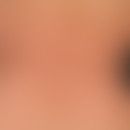DefinitionThis section has been translated automatically.
Rare edema formation occurring after repetitive (vibratory) shocks to the skin, limited to the site of action, usually painful or burning or itching.
EtiopathogenesisThis section has been translated automatically.
Often autosomal dominant inheritance mechanism. Sporadic cases also known.
You might also be interested in
ClinicThis section has been translated automatically.
After vibratory trauma (working with percussion drills, motor mowers, jogging), first redness appears at the site of exposure, followed by an itchy or painful swelling. Maximum of symptoms a few hours after exposure, after 24 hours skin condition returns to normal.
HistologyThis section has been translated automatically.
Edema of the deep dermis and subcutis. Interstitial and periadnexual infiltrate of eosinophilic and neutrophilic leukocytes, T-lymphocytes and monocytes. Detection of proinflammatory cytokines such as TNF-alpha, IL-3, IL-6 as well as the expression of adhesion molecules (VCAM-1, ICAM-1) in the vessel walls.
TherapyThis section has been translated automatically.
Avoid triggering mechanisms as far as possible. The only effective therapy is the administration of systemic glucocorticoids such as prednisolone (e.g. Decortin H) initially 50-80 mg/day, with the lowest possible maintenance dose. Antihistamines are generally ineffective.
LiteratureThis section has been translated automatically.
- Cap JP et al (1985) The effect of ketotifen in Urticaria factitia and Urticaria cholinergica in a crossed double-blind experiment. Dermatologist 36: 509-511
- Butcher M, grave J (2004) Pyhsikalische Urtikaria. dermatologist 55: 344-349
- Kontou-Fili K et al (1997) Physical urticaria:classification and diagnostic guidelines. Allergy 552: 504-513
Outgoing links (1)
Cytokines;Disclaimer
Please ask your physician for a reliable diagnosis. This website is only meant as a reference.




